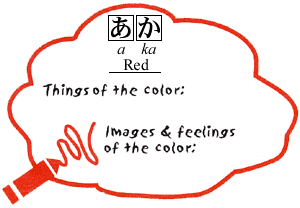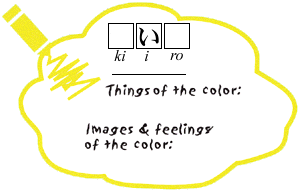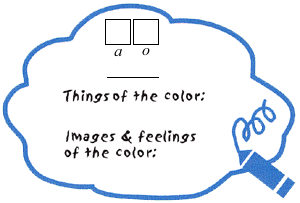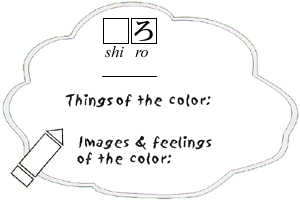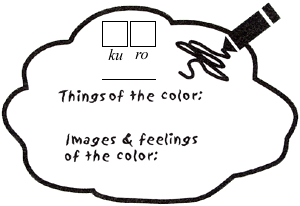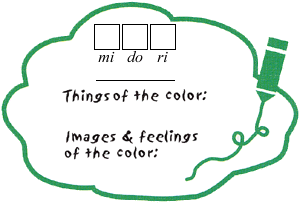 Red
Red
|
| |
 1.
Taiyoo no iro 1.
Taiyoo no iro 
The color of the sun
If you ask "What color is the sun" most Japanese will answer, "Red."
What color do you draw the sun? And what kinds of things do you
associate with the color red? |
| |
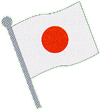 2.
Hi no maru 2.
Hi no maru 
The "rising sun"; Japan's national flag
Japan's flag consists of a red sun on a white ground. Flags have
been used from long ago as symbols of a nation and its people. One
can get a glimpse of a country's culture by seeing how colors, not
to mention motifs, are used to express geographical location, religious
beliefs, ways of thinking, and traditions. The round red ball on
Japan's flag represents the sun, but for other countries, red can
represent blood, revolution, independence, courage, soldiers, love,
communism, fire, and zeal. What colors are used in the flag of your
country? What do the colors in the flag signify ? |
| |
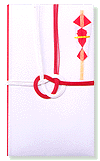 3.
Koohaku no mizuhiki 3.
Koohaku no mizuhiki 
Red and white gift wrap string ornaments
Mizuhiki are made by rolling thin strips of paper into strings
which are then covered with glue and dried.
Red and white are colors used to decorate and enhance places where
auspicious and happy occasions are held. The photograph shows shuugi-bukuro
 , gift wrap string ornaments for weddings
and other auspicious occasions. , gift wrap string ornaments for weddings
and other auspicious occasions. |
| |
 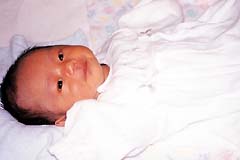 4.
Akachan 4.
Akachan 
Baby
A newborn baby is bright red, thus the name.
|
| |
 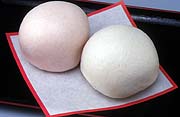 5.
Koohaku manjuu 5.
Koohaku manjuu 
Red and white bean-jam sweets
Pairs of red and white manjuu are frequently presented as
gifts to guests attending wedding receptions, and other auspicious
commemorative events. |
| |
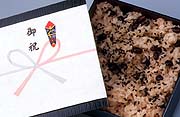 6.
Sekihan 6.
Sekihan 
Red-bean rice
Rice cooled with azuki  beans.
Like koohaku manjuu, sekihan is a dish freqently served
on auspicious occasions. beans.
Like koohaku manjuu, sekihan is a dish freqently served
on auspicious occasions. |
| |
 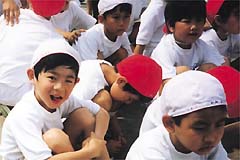 7.
Koohaku taikoo 7.
Koohaku taikoo 
Red and white team competition
Competitors at elementary schools and of other groups are usually
divided into "red" and "white" teams. When large groups are divided
into several teams, other colors such as blue, yellow, and green
may be used, but whenever there are two sides, they are usually
called the "red" and "white" teams. |
| |
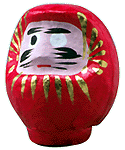 8.
Daruma 8.
Daruma 
Doll representing the meditating figure of Daruma (Bodhidharma),
the founder of the Zen sect of Buddhism. The base of the figure
is weighted so that even when toppled over, the doll stands upright
again. The eyes are simply a pair of white circles, as here. You
make a wish and paint in one eye. When the wish comes true, you
can celebrate by painting in the other. |
| |
Phrases
 Akaku naru Akaku naru  : Embarrassment, to blush
: Embarrassment, to blush
 Makka ni natte okoru Makka ni natte okoru  : Grow red with anger
: Grow red with anger
 Akaji Akaji  : Red ink, deficit spending, loss (cf., kuroji
: Red ink, deficit spending, loss (cf., kuroji  : black ink, profits)
: black ink, profits)
 Aka no tanin Aka no tanin  : A complete or perfect stranger
: A complete or perfect stranger |
|

 *
* How many colors are there in the rainbow ? Obviously, the actual number of colors in the rainbow does not differ, but in Japan, it is said there are seven, in the United States, six, in Germany five, and in Russia, the answer seems to differ from one person to another.
How many colors are there in the rainbow ? Obviously, the actual number of colors in the rainbow does not differ, but in Japan, it is said there are seven, in the United States, six, in Germany five, and in Russia, the answer seems to differ from one person to another. In addition, specific colors have associations with particular things. For example, most Japanese think of apples as red. Colors may be linked to certain things and images, as well as to expression of certain feelings.
In addition, specific colors have associations with particular things. For example, most Japanese think of apples as red. Colors may be linked to certain things and images, as well as to expression of certain feelings. "Red," for instance, in Japan evokes images of auspicious or happy occasions symbolized by the colors red and white ( koohaku
"Red," for instance, in Japan evokes images of auspicious or happy occasions symbolized by the colors red and white ( koohaku  ). Such images and associations of colors, however, are not necessarily universal. Differences in modes of expression and images emerge as a result of many factors including the natural environment, social conditions, and traditional culture. In this issue, A Day in the Life offers materials and examples for considering the differences and similarities in the language and role of colors as reflected in Japanese language and culture.
). Such images and associations of colors, however, are not necessarily universal. Differences in modes of expression and images emerge as a result of many factors including the natural environment, social conditions, and traditional culture. In this issue, A Day in the Life offers materials and examples for considering the differences and similarities in the language and role of colors as reflected in Japanese language and culture.
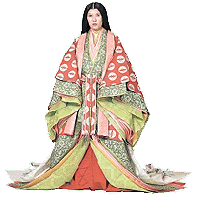 Juunihitoe
Juunihitoe  ( 12-layered kimono ) : The costume of high-ranking ladies-in-waiting in the court from the Heian period ( 710-94 ) onward consisted of 12 or more layers. Colors passed down from olden times often come from the names of flowers and plants. Various hues of pink, for example, include sakura
( 12-layered kimono ) : The costume of high-ranking ladies-in-waiting in the court from the Heian period ( 710-94 ) onward consisted of 12 or more layers. Colors passed down from olden times often come from the names of flowers and plants. Various hues of pink, for example, include sakura  ( cherry blossom or pale pink ), momo no hana
( cherry blossom or pale pink ), momo no hana  ( peach blossom or bright pink ), koobai
( peach blossom or bright pink ), koobai  ( dark pink plum pink ). Many tints of green are named after plants : wakakusa
( dark pink plum pink ). Many tints of green are named after plants : wakakusa  is the bright lush green of new grass in spring, aodake
is the bright lush green of new grass in spring, aodake  is the bright green of new growth bamboo, and oitake
is the bright green of new growth bamboo, and oitake  is the dark, grayish green of the mature bamboo trunk. Other color names come from plants grown specifically for dyestuffs such as
is the dark, grayish green of the mature bamboo trunk. Other color names come from plants grown specifically for dyestuffs such as  benibana ( safflower ). One of the most favored colors of the Heian period was the bright yellow of the yamabuki flowers of a variety of rose ( Kerria Japonica ).
benibana ( safflower ). One of the most favored colors of the Heian period was the bright yellow of the yamabuki flowers of a variety of rose ( Kerria Japonica ).
 Red
Red 1.
Taiyoo no iro
1.
Taiyoo no iro 
 2.
Hi no maru
2.
Hi no maru 
 3.
Koohaku no mizuhiki
3.
Koohaku no mizuhiki 
 , gift wrap string ornaments for weddings
and other auspicious occasions.
, gift wrap string ornaments for weddings
and other auspicious occasions.
 4.
Akachan
4.
Akachan 

 5.
Koohaku manjuu
5.
Koohaku manjuu 
 6.
Sekihan
6.
Sekihan 
 beans.
Like koohaku manjuu, sekihan is a dish freqently served
on auspicious occasions.
beans.
Like koohaku manjuu, sekihan is a dish freqently served
on auspicious occasions. 7.
Koohaku taikoo
7.
Koohaku taikoo 
 8.
Daruma
8.
Daruma 
 Akaku naru
Akaku naru  : Embarrassment, to blush
: Embarrassment, to blush : Grow red with anger
: Grow red with anger : Red ink, deficit spending, loss (cf., kuroji
: Red ink, deficit spending, loss (cf., kuroji  : black ink, profits)
: black ink, profits) White
White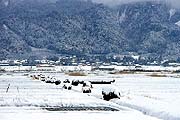

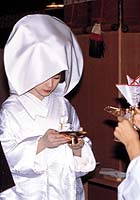

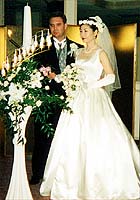

 ( lit., "go back to the blank page" ) : Means going back to the
begining, starting at "square one," etc.
( lit., "go back to the blank page" ) : Means going back to the
begining, starting at "square one," etc. ( lit., "look with the whites of one's eyes" ) : To scorn, treat
coldly
( lit., "look with the whites of one's eyes" ) : To scorn, treat
coldly  Black
Black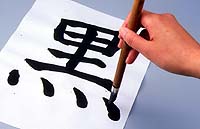

 (black) and the radical
(black) and the radical  (earth).
(earth).
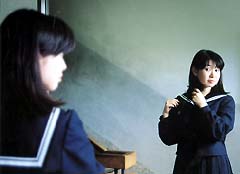

 Kurokami
Kurokami  (Black hair) :
(Black hair) :  ( lit., "white eye, black eye")
: White of the eye and iris (and pupil) of the eye
( lit., "white eye, black eye")
: White of the eye and iris (and pupil) of the eye  13.
Mo
13.
Mo 
 (condolence gift) envelope stringed
by black and white mizuhiki.
(condolence gift) envelope stringed
by black and white mizuhiki. 
 : To roll one's eyes in fright, surprise, or anguish
: To roll one's eyes in fright, surprise, or anguish ( lit., "black belly" ) : Ill-intentioned, evilhearted
( lit., "black belly" ) : Ill-intentioned, evilhearted  Yellow
Yellow
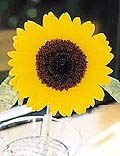

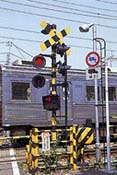

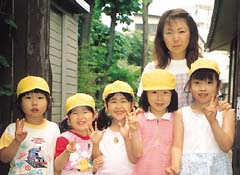

 ( lit,. "beak is yellow" ) : Refers to someone who is inexperienced
or young
( lit,. "beak is yellow" ) : Refers to someone who is inexperienced
or young ( lit., "yellow voice" ) : The shrill voice of women and children
( lit., "yellow voice" ) : The shrill voice of women and children Blue
Blue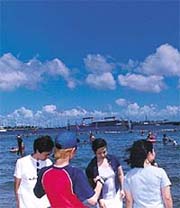

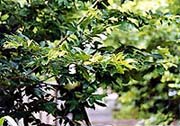 20.
Ao and Midori
20.
Ao and Midori 
 ,
seinen
,
seinen  , aokusai
, aokusai  ,
and aonisai
,
and aonisai  .
.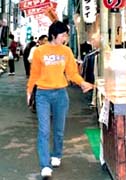

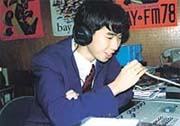

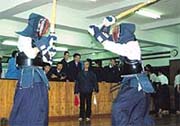

 ( to grow pale ) : To pale when ill or stricken by fear or worry
( to grow pale ) : To pale when ill or stricken by fear or worry
 Green
Green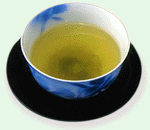

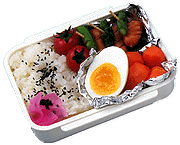 25. Ryokuooshoku yasai
25. Ryokuooshoku yasai




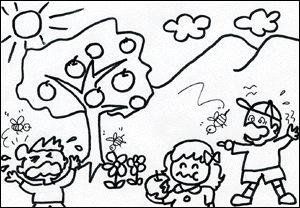



 passion, celebration, etc.
) and do the same for ( 2 ).
passion, celebration, etc.
) and do the same for ( 2 ).